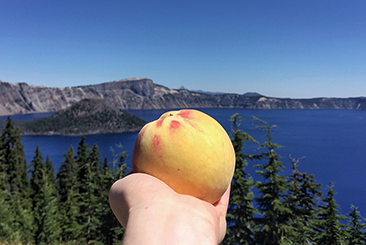Barbecue Sunchoke Chips

Kinetic energy states that a body in motion stays in motion. Turns out the same is true for your hand when it's scooping these crispy delights into your mouth. Taking some artistic liberties with physics here. Plain sunchoke chips are mighty good, but combine their sweet nuttiness with a dusting of Vegetable Kingdom's barbecue seasoning and the flavor is something special.
Miscellany
Frying Oil
Pure olive oil has a smoke point somewhere between 355-405°F according to The Google. Based on my experience, quality olive oil holds up just fine when I use it to fry at temperatures around 350-360°F. The challenge is when an olive oil has impurities because a lower quality oil has been blended in.
Similar to honey (apparently the world's third most faked food), there's a lot of fraud in the olive oil supply chain. I buy from local folks such as Katz Farm and Trattore Farms to avoid this issue. With all of that said, olive oil is on the expensive side as a frying oil. Refined peanut, canola, or similar neutral oils with a high smoke point will also work.
In terms of quantity, frying recipes often require what seems like a large amount of oil for the average home cook. I expand upon this under Instructions, but I've never needed to use more than about 2 inches of oil to get the job done. It means I have to process more batches, but the frying time is about 1 1/2 minutes so that's not a big deal.
Tubular
What's in a name? Not much. Though sunchokes are also known as Jerusalem artichokes, they hail from North America and aren't actually related to artichokes. I'm partial to the terms "sunroot" and "earth apple" but for the sake of this post I'll use sunchoke.
Sunchokes are a knobby tuber that's part of the sunflower Helianthus Tuberosus - it looks like a Jurassic-size daisy. What exactly is a tuber? For the purposes of cooking, tubers (potatoes, sunchokes) and taproots (carrots, beets) are simply below-ground root vegetables. More specifically, tubers are an enlarged portion of the root system that serve multiple functions including the storage of food and energy. This page has some helpful illustrations.
Original vs. Adapted
Shake, Shake, Shake (or not)
The recipe in Vegetable Kingdom suggests combining the cooked sunchokes and barbecue seasoning in a bag and then shaking it to coat the chips. I found that the chips are a bit too fragile to shake plus it helps to dust them right out of the frying pot. Additional notes under Instructions.
Sweetness
The recipe calls for raw cane sugar but I used organic cane sugar since that's what I had on hand. I plan to stick with organic cane sugar since the flavor was great.
Recipe Tips
Knobbly
Sunchokes are lumpy bumpy tubers. Do your best with the washing but don't fret if you see some dirt in the creases. The sunchokes will get a good rinse once they're sliced. I'm quite pleased that knobbly is a real word.
Mandoline
If you're going to the trouble of making chips, I highly recommend a mandoline. This will help will help move the process along and promote even cooking. I use my mandoline all the time for pickles, peppers, pickled red onions, and more. I even managed to convert my mother-in-law from her death-defying "antique" mandoline to the Rösle.
Lemon
I forgot to put lemon in the water on one occasion and didn't notice any discoloration with the sunchokes. The cookbook suggests lemon so it's up to you.

Sunchokes at Weiser Family Farms - Santa Monica Farmers Market
Farmers | Artisans
I make an effort to source my food from California artisans with a special focus on the Santa Monica Farmers Market. Below is a list of the folks who contributed to this dish.
- Coleman Family Farms / Sunchokes
- Weiser Family Farms / Sunchokes
- Katz Farm / Olive Oil
- Trattore Farms / Olive Oil
Tools
- Rösle Mandoline/Slicer - This tool has a beautiful design and is easy to use and clean. Pickled Red Onions, Gjelina's Spicy Sweet Pickles, and Superiority Burger's Sloppy Dave all call for a mandoline. I recommend buying a replacement blade to have on hand though it took quite a while before I swapped mine out (probably waited too long).
- Mk4 Thermapen Digital Thermometer - I have three Thermapen digital thermometers that are distributed between my home, the Airstream, and my mother-in-law's house. They're fast, easy to clean, and the probe makes a perfect cake tester.
- Small Mesh Strainer - I find small strainers come in handy for a number of miscellaneous tasks including dusting barbecue seasoning on sunchoke chips.
- Rösle Wire Strainer - I had a spider strainer that turned into a violent little thing. Wires would come loose and stab me but for some reason I tolerated this for years. I finally replaced it with Rösle's skimmer (they make many of the stainless tools in this list) and am happy with that decision. Cook's Illustrated also rates Rösle's skimmer at the top of the list. Though the width looks small online, the capacity is great. Bonus that it doesn't have those little wires that can break and cut your hand.
- Baking Sheet
- Non-reactive Medium or Large Pot
Ingredients
Barbecue Seasoning - Makes About ½ Cup (Recipe from Vegetable Kingdom)
- 1 teaspoon whole white peppercorns
- 2 tablespoons sweet paprika
- 2 tablespoons smoked paprika
- 1 tablespoon organic cane sugar
- 2 teaspoons fine sea salt
- 1 teaspoon onion powder
- 1 teaspoon garlic powder
- 1 teaspoon ground cumin
- 1 teaspoon chili powder
- Pinch of cayenne pepper
Frying
- Frying oil (olive oil, refined peanut, or similar)
- 1 to 1 1/2 pounds medium/large sunchokes Note: The larger and less knobby the better in terms of slicing.
Instructions
- Fill a large bowl with water and set aside.
- Slice the sunchokes about 1/8-inch thick. Drop the slices into water to prevent oxidation. Note: On my mandoline (mentioned under Recipe Tips), it's the 7th "click" from the closed position.
- Set up your frying station. Place a baking sheet next to the stove and line with a piece of foil and then two layers of paper towels. Place the BBQ seasoning, small fine mesh strainer/sifter, skimmer, and Diamond kosher salt to the side. Most importantly, place a digital thermometer nearby so that you can manage the oil temperature.
- Place two dish towels on the counter and then place two layers of paper towels on each.
I like to use about 2 inches of oil in a medium saucepan (less waste) but it means I have to fry several batches. If you want to get the job done a bit faster, use a larger pot though I would still only fry in about 2 inches of oil.
- Add the oil to your pot of choice and set the heat to medium. The target temperature is 350-360°F.
- While the oil is coming up to temperature, grab a couple handfuls of sunchoke slices, shake off the excess water, then arrange them in a single layer on the paper towels. Place another layer or two of paper towels on top and repeat. You want the sunchoke slices to be nice and dry.
- Once the oil is ready, drop a generous handful (depending on your pot size) into the pot but don't overcrowd it - the oil will bubble vigorously. Note: I occasionally turn the heat up a smidge when I drop the sunchokes in since the oil temperature drops.
- Cook for 1 1/2 to 3 minutes, using the skimmer to poke around and ensure the sunchokes aren't sticking together. I also move the sunchokes around once or twice, submerging/flipping them during that process. This step isn't an exact science so don't get too hung up on it.
- When the sunchokes are just about done, the oil will become curiously quiet as if the temperature suddenly dropped. Watch closely at this point - the sunchokes will quickly take on some color. Once they're golden, scoop the sunchokes out with the skimmer and transfer to the baking sheet lined with paper towels. The color will continue to darken from the carryover cooking so don't let the chips get too dark in the oil. Immediately dust with BBQ seasoning and a pinch of kosher salt. Gently toss then taste to gauge if you're happy with the seasoning.
- Repeat above steps until all of the sunchoke chips are made.
- I store cooled Barbecue Sunchoke Chips in an airtight container but, as Chef Bryant Terry rightly points out, they don't last long.
Coming Up
- Subscribe at the bottom of this page for the Chic Eats monthly roundup. It includes new and updated recipes along with a grab bag of content that was interesting enough to share around the dinner table.







